The former F.M.S. Railway Administration Office - The last Indo-Saracenic structure of Kuala Lumpur
 |
| Keretapi Tanah Melayu Bhd (KTM) Headquarters |
Railway service in Selangor commenced on 15 September 1886 with the opening of its first line from Bukit Kuda in Klang to Kuala Lumpur, a distance of 19.5 miles (31.4km). As the railway service business grew steadily the necessity to have a proper and more organized administration office had arisen.
When the original line from Bukit Kuda to Kuala Lumpur was extended to Batu and Rawang to the north on 7 November 1892, a new station (normally referred to as the 1892 Kuala Lumpur Railway Station) was built on a new site 26 chains south of the first station. It was the present site of the Old Kuala Lumpur Railway Station. The first Kuala Lumpur Station was demolished and on its site a new permanent building was erected to serve as the Railway Office. It was to accommodate the administrative office of the then Selangor Government Railways because it was also the site of goods yard.
In 1901 Federated Malay States (FMS) Railways was founded by merging all the state railway services in Malaya. Upon the formation the company acquired various railways that were developed separately in various parts of Malaya, and oversaw the largest expansion and integration of the colonies' rail network encompassing throughout Malaya and Singapore with lines spanning from Singapore to the south to Padang Besar (near the border with Siam) to the north.
With the centralization of railway services under FMS Railways and Kuala Lumpur being the central office, the capacity of the existing railway administration office was hardly adequate. The new FMS Railway Administration Central Office was then built and completed in 1905 on the same site. I have blogged about this elegant Indo-Saracenic edifice in the earlier blog entry here.
However, even with the second FMS Railway Administration Central Office, it was fast found obsolete and its location inconvenient as it was situated rather far from the main Kuala Lumpur Railway Station. They decided to construct another building, larger and adjacent to the then spanking new Kuala Lumpur Railway Station (Completed in 1911). The design of the new FMS Railway Administration Building was again entrusted to the FMS Government Architect, Arthur Benison Hubback F.R.I.B.A. The design was ready in 1913. And it was also the last building in Kuala Lumpur designed by AB Hubback.
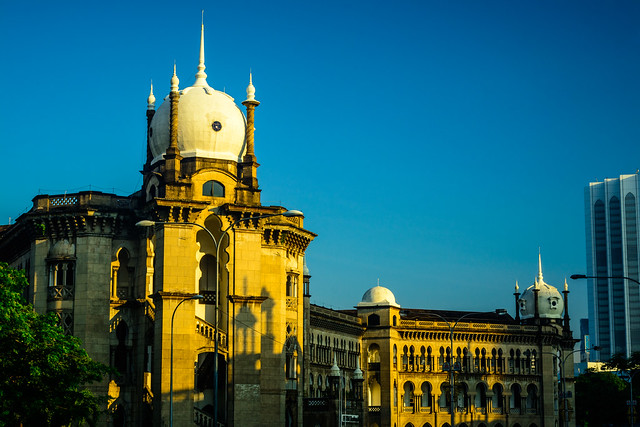 |
| Large and small domes |
CONSTRUCTION PROJECT
An announcement on the instructions to submit tenders for the construction of new central offices in Kuala Lumpur for the Federated Malay States Railways was published in an advertisement section in The Straits Times dated 21 January 1914. The announcement stated that tenders would be received up to noon of Monday 4 May 1914 whereas the project value was estimated at $508,000 Straits Dollars. The contract was subsequently won by Contractor Chua Hua Tong after going through the normal tender process and construction work began in the same year later. The construction was supervised by another FMS Government Architect named W. Huxley. By this time, in 1914, AB Hubback had left for England on a long leave to fight for Great Britain in the First World War. He joined the 19th battalion, London (territorial) regiment, as a Major. He had never returned to Malaya ever since.
The construction work began in the same year the First World War erupted in Europe. This caused some delays and slow progress in completing the building. Although this part of the world was not directly affected by World War One, sluggish economic activities and shortage of construction materials couldn't be avoided. The building was eventually completed at the end of September 1917 at the total cost of $587,000 Straits Dollars and it was expected to be occupied by 1 October 1917 as reported by The Singapore Free Press and Mercantile Advertiser dated 27 September 1917.
ARCHITECTURAL FEATURES
This distinctive 3-storey building is located at the corner of Jalan Sultan Hishamuddin (formerly Victory Avenue) and Jalan Perdana (formerly Venning Road). Its main entrance faces the main entrance of the old Kuala Lumpur Railway Station separated only by the busy Jalan Sultan Hishamuddin.
Ashley Jackson in his book entitled Buildings of empire described the two monumental structures as The Two Sisters. He wrote "The 'Two Sisters' are a pair of striking colonial buildings close to Kuala Lumpur's famous Merdeka Square. One is the headquarters of Keretapi Tanah Melayu Berhad, the Malayan Railways Limited, the other, standing opposite across a busy main road, is the city's former central railway station, built in extravaganza Indo-Saracenic style".
 |
| The "Two Sisters" |
The former FMS Railway Administration Office (now Keretapi Tanah Melayu Bhd Headquarters) was designed in Indo-Saracenic architectural style which is a mixed bag of Mughal architecture of India, the European Neo-Classical, Neo-Gothic and Neo-Renaissance architecture. It was first introduced in British India and the idea was later exported to British Malaya, Singapore and Burma. Apart from the name Indo-Saracenic it is also called British Raj, Mughal-eclectic, Neo-Mughal or Neo-Saracenic architecture.
One of the most prominent features of Indo-Saracenic architecture is bulbous dome or it is also called onion-shaped dome. The roof of this building is adorned by four large domes including the central dome which is the largest among all. The central dome is topped with a cupola while each of the three large domes sits on a tower that encases a staircase from ground floor to the top floor. At each of the four corners of this dome, there is a twisted column. In addition to this, there are four smaller domes and each of it is placed on the four main pillars.
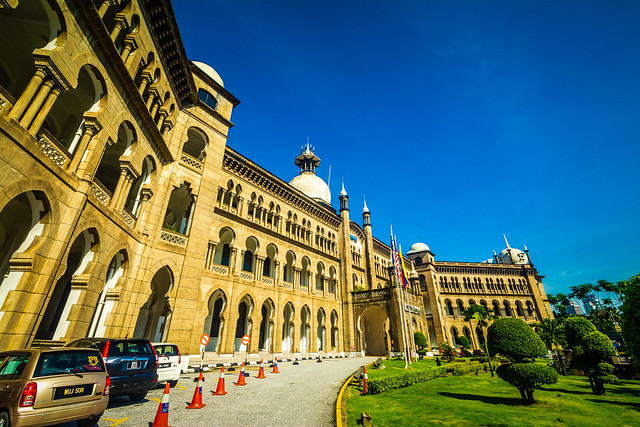 |
| Rows of arches skirting the entire building |
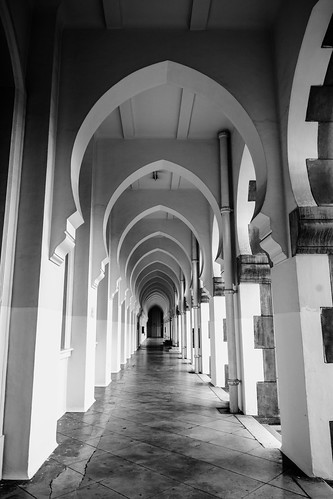 |
| Airy arcade on each floor of the building |
On every floor of the 3-storey building there are multiple arches along the arcade that skirts the entire building. Aesthetically the repetitive arches create harmonious pattern and appear pleasing to the eyes. Practically arches provide shade against rain and direct sunlight besides giving airy atmosphere to the long arcade.
There are different shapes of arches that adorn this building. On the ground floor is a row of pointed horseshoe arches along the arcade and every two arches are flanked by pilasters topped with garlic-shaped finials - the architectural style most likely borrowed from the Neo-Renaissance style. On the first floor, there is a row of semi-circular arches and either side of arch is supported by three columns. Meanwhile the third floor has interlocked pointed horseshoe with single column. The columns are largely influenced by Roman and Neo-Classical architecture.
 |
| Different shapes of arches and jali below each arch along the arcade on the first and second floor and small chhatri tops each minaret |
In addition to this, on the porte-cochère and in the middle of the building two corbel arches flank a semi-circular keyhole arch. And the porte-cochère is decorated with minaret on both sides topped with small chhatris - chhatri is one of the features in Mughal architecture.
Meanwhile on the first and second floor, under each arch there is waist-high perforated concrete/stone fence. This is one of the features of Indo-Saracenic architecture borrowed from Mughal architecture. In Urdu, it is called jali. Jali is not purely decorative but also serves as wind holes that gives airy atmosphere to the arcade.
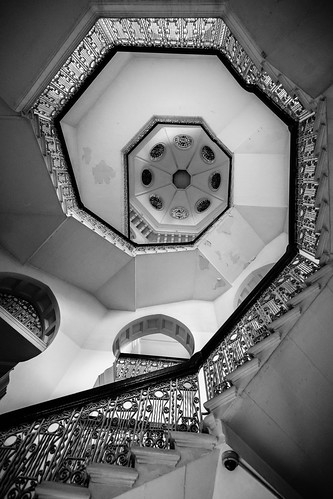 |
| The octagonal cantilever spiral staircase |
Upon entering the building from the main entrance, you would be welcomed by the impressive octagonal cantilever spiral staircase underneath the central dome. The staircase leads all the way up to the top floor and the central dome from ground floor. The Singapore Free Press and Mercantile Advertiser dated 27 September 1917 reported that this cantilever staircase was the only example, at that time, could be found on the east of Suez! The staircase is complete with wrought iron banister and timber handrail. Quite impressive architectural and engineering feats at that time.
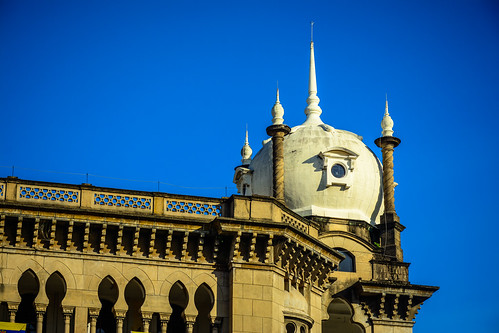 |
| Chhajja - The projecting or overhanging eaves or cover of a roof, usually supported on large carved brackets. |
The next feature that fits the definition of Indo-Saracenic architecture is the projecting eaves supported by carved bracket along the perimeter of the building roof which, again in Mughal Architecture, is called chhajja in Urdu.
 | |
|
Another feature that can be identified originating from 16th century Mughal architecture is jharokha or jharoka (in Urdu). It is an enclosed overhanging balcony that juts forward from the wall plane. It both adds to the architectural beauty of the building itself or for a specific purpose. In the olden days, one of the most important functions it served was to allow women to see the events outside without being seen themselves. Alternatively, these windows could also be used to position archers and spies.
Upon its completion in September 1917 this Indo-Saracenic structure was the tallest in the Federated Malay States (comprising Selangor, Perak, Pahang and Negeri Sembilan).
In 1940 all reinforced concrete cornices were renewed in 1940 at a cost of $22,000 Straits Dollars. Unfortunately the North Wing was bombed during World War II and partially damaged while the second floor of North Wing was also damaged in a fire on 14 November 1968.
This building was one of the last three government buildings designed by the prolific Government architect Arthur Benison Hubback and was the last one for Kuala Lumpur. The other two were the Ipoh Railway Station and the Ubudiah Mosque in Kuala Kangsar. Although all three buildings were completed in 1917, AB Hubback left Malaya for England in 1914 to fight in World War I for the British Government and never came back to Malaya.
THE NATIONAL HERITAGE
In Kuala Lumpur, within the period of a decade the British Colonial Government built a series of prominent public/government buildings starting from the Government Offices (the Sultan Abdul Samad Building) - completed in 1897 and ending with this building, the former FMS Railway Administration Office, completed in 1917. They formed a magnificent landmark of Kuala Lumpur and became the symbol of power, wealth and influence the British Empire had over this part of the world.
After World War I, the popularity of Indo-Saracenic architecture came to an end. The British colonial government was no longer able to build grand monumental structures after World War I as it had to deal with crises, one after another including the sharp fall in rubber and tin price in the world market, influenza epidemic and unemployment.
On 1 October last year this building turned 100 years old. Unfortunately hardly anybody was aware of it and neither was there any event to celebrate its centenary anniversary as far as I know. However the elegant building still stands strong
That said, credit should still be given to Keretapi Tanah Melayu Berhad (KTM) for preserving and taking good care of this precious heritage building. The building now houses the headquarters of KTM which is a government-linked company that operates and administers Malaysian railway services nationwide.
This building was gazetted as the national built heritage under National Heritage Act 2005 (Act 645) on 10 May 2012.
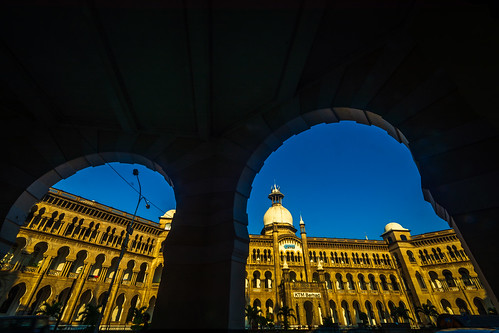 | |
|
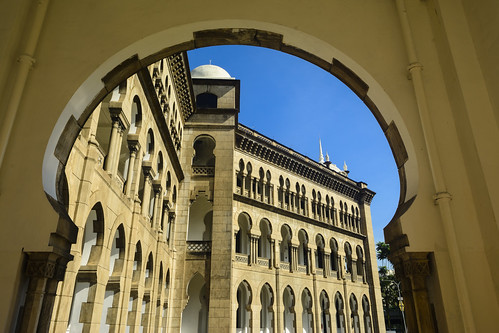 |
| The north wing is seen through an arch |
All the photographs displayed here are copyrights of Zain Abdullah (mzabdullah [AT] gmail.com) UNLESS stated otherwise. Photographs may not be copied, published or in any way reproduced or distributed electronically or in hard print without an explicit consent from the author.
REFERENCES
A Chronology of Brigadier General Arthur Benison Hubback’s Life 1871-1946. (2017, November 5). Retrieved from https://www.abhubback.com/copy-of-life-times
Government of Federated Malay States. Construction of new central offices in Kuala Lumpur for the Federated Malay States Railways. (1914, January 21). The Straits Times. Retrieved from http://eresources.nlb.gov.sg
History of railways in Selangor. (n.d.). Retrieved January 4, 2018, from Asian Railways website: http://searail.malayanrailways.com/Selangor/Selangor.htm
Jackson, A. (2013). Buildings of empire. London: Oxford University Press.
Metcalf, T. (2002). An Imperial Vision: Indian Architecture and Britain's Raj. Oxford: Oxford University Press
Morris, J., & Winchester, S. (1986). Stones of empire: The buildings of the Raj. Oxford: Oxford University Press
Trilby touch building list. (2017). Retrieved from https://www.abhubback.com/trilby-s-touch
Untitled. (1917, September 27). The Singapore Free Press and Mercantile Advertiser. Retrieved from http://eresources.nlb.gov.sg
Yat, M.L. (2016). Architecture and urban form in Kuala Lumpur: Race and Chinese spaces in a postcolonial city. New York, NY: Routledge.
This is a good post. railways parts from India. Unotech Engineering offers a complete bouquet of components for on-road & off-road applications. Engine components, Suspension parts & Power train, Locomotive & Defense components.
ReplyDelete